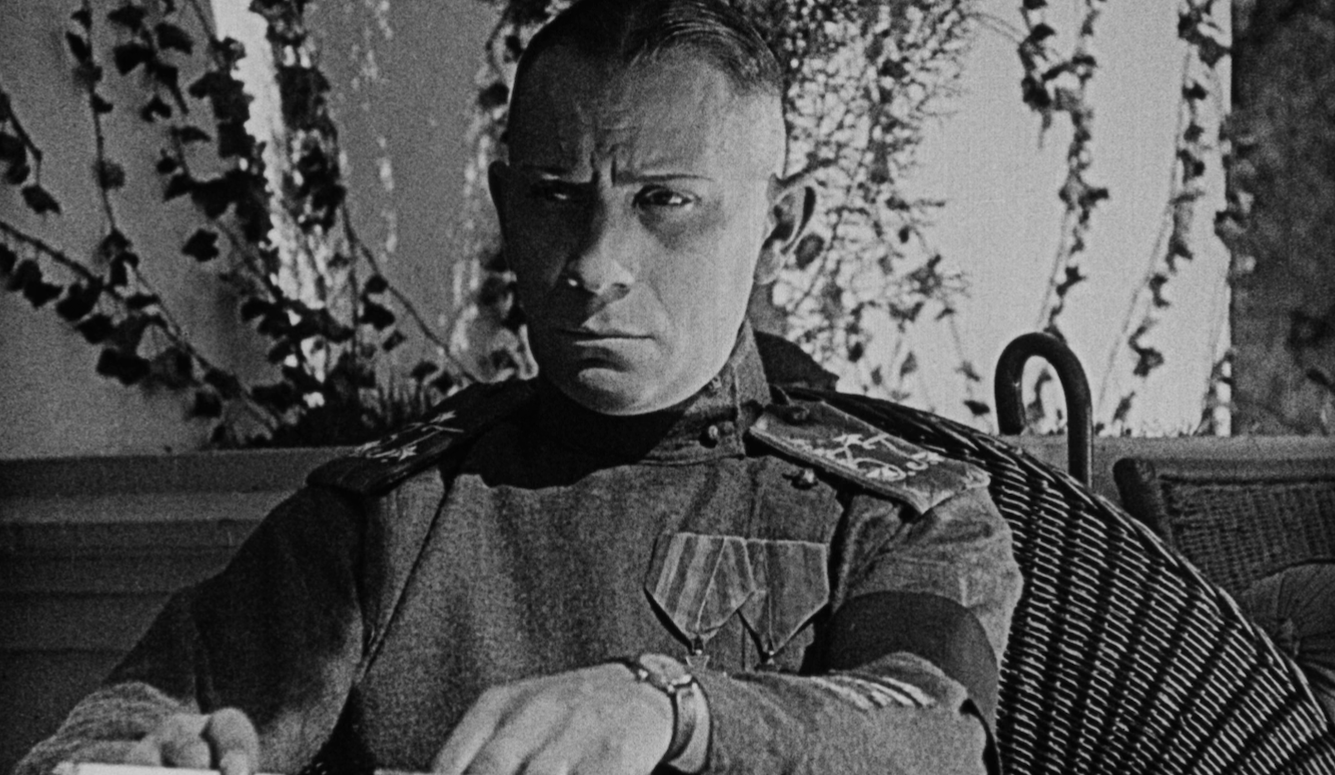Art and Culture
Hollywood Autocrat
A newly restored Blu-ray release of ‘Foolish Wives’ offers a welcome reintroduction to one of cinema’s most gifted and eccentric artists.

Erich von Stroheim’s Foolish Wives (1922) was the first movie to have cost over a million dollars. It is not quite what you would expect: there are no special effects, elaborate action sequences, or spectacular reconstructions of the distant past. It looks instead like an unusually expensive film noir.
Foolish Wives is the story of a trio of sleazy pseudo-aristocratic con artists, a phony Russian count (played by Stroheim himself) and his two seductive “cousins” (who may or may not be his mistresses). They have leased the Villa Amorosa on the Mediterranean seashore as a base of operations for defrauding and blackmailing high-society gamblers in Monte Carlo.
The count might not really be a captain in the Imperial Russian Army, but he is a good shot: he spends his mornings standing on the windswept terrace in a sumptuous quilted silk dressing gown aiming his pistol at targets on the rocks. His breakfast includes caviar and a shot of “oxblood” (a cocktail of claret and champagne that he uses as an eye-opener). His cousins fight constantly for his attention, and one of the maids at the villa is desperately in love with him.
During the day, the count prowls around Monaco in a spotless uniform, smoking endless long cigarettes whilst he leers through his monocle at the naïve rich women who are his preferred prey. Foolish Wives tells the story of how this phony aristocrat attempts to seduce, and fleece, the wife of an American diplomat.
Unlike so many other American silent films, Foolish Wives feels less like a filmed stage play than a photographic version of a 19th-century novel. The psychological realism is impressive, to say nothing of the set design, art decoration, and general feeling of catching a glimpse of the real world. Yet Foolish Wives was not shot anywhere near Monte Carlo. Indeed, Stroheim had not yet been to the south of France when he made this film.
As a filmmaker, Stroheim was a meticulous craftsman. He not only devoted close attention to sets, props, and costumes, but he also went through an incredible amount of film, shooting takes and retakes of every scene into the small hours of the morning. He expected quite a lot of what he shot to make it into the final cut of the movie: Stroheim saw no reason why an audience should not be willing to sit through four, or six, or nine hours of narrative, so long as he was the one who put it together.
Perhaps Stroheim’s greatest extravagance as a director involved getting details right, not least of décor: he was prepared to hold up shooting if the gold-rimmed champagne glasses used in the background of the main action were not obviously perfect. In early Hollywood, most directors had no problem using (for example) blackberry jam in lieu of caviar, because they thought that audiences could not tell the difference in a black-and-white film. Stroheim, by contrast, refused to cut corners even where background details were concerned.

More from the author.
If Stroheim was so obsessed with authenticity, why didn’t he film Foolish Wives on location? It would probably have been cheaper for Universal Studios. But Stroheim had no experience of the world that he claimed to be recreating. His seemingly encyclopaedic knowledge of military matters, and the habits and practices of the aristocracy, came from a greater distance than he admitted: he was the son of a struggling couple who owned a hat shop. His army career can be measured in weeks, not years.
Stroheim was, at heart, a performance artist: his life was a splendid artistic creation that convinced even his family, and his closest friends. He was never merely play-acting as a temperamental genius, he was the genuine article. Foolish Wives is the first masterpiece of one of Hollywood’s most innovative pioneers; and the stories behind its making are at least as absorbing as the film itself.
Stroheim was given the green light to make Foolish Wives by the producer and movie mogul Carl Laemmle (1867–1939), who deserves to be the subject of a biopic or miniseries. Incredibly, the last full biography of Laemmle in English was written by John Drinkwater in 1931. If you cannot read German, you will find the main outlines of his extraordinary life in Neal Gabler’s engrossing 1988 study An Empire of Their Own, which focusses on the great producers and studio heads of early Hollywood, and shows how uncannily Laemmle’s life fits the mythic patterns of the American Dream.
Laemmle was born in Laupheim, Germany, and received a one-way ticket to America on his 17th birthday. He settled first in Chicago, saving his pennies so he could enjoy German theatre and operetta on Sunday afternoons, along with the occasional 10-cent glass of beer. Just before he turned 40, he impulsively invested in a nickelodeon (a cheap movie theatre). Within a year, he was one of the most successful cinema owners in America. Later, he moved out to Hollywood and founded Universal Studios.
“Uncle Carl,” as Laemmle was universally known, loved taking chances. This was how he discovered Erich von Stroheim. He also talent-spotted a brilliant 19-year-old workaholic named Irving Thalberg (1899–1936), who has become a legend in his own right thanks to F. Scott Fitzgerald (1896–1940). Thalberg was the model for the tragic boy-genius Hollywood mogul in Fitzgerald’s unfinished final novel The Last Tycoon, which was posthumously published in 1941. Thalberg would also play a pivotal role in Stroheim’s career, more than once.
Thalberg was a sickly, delicate child; he was doomed not to live long, and his doting mother wanted him to fulfil his promise (not to mention her own ambitions). She got him a position at the New York offices of Universal Studios, where Laemmle was impressed by his shrewdness and work ethic; by the age of 20, Thalberg was more or less running Universal single-handedly. To him we owe the Hollywood studio system, for better or for worse.
Not everybody loved Thalberg; his reputation is memorably trashed in My Lunches with Orson: Conversations Between Henry Jaglom and Orson Welles (edited by Peter Biskind, 2014). Welles (1915–85) was born too late to have locked horns with Thalberg; even so, he objected vehemently to the system of standardised, mass-produced “quality motion pictures” that Thalberg developed at Metro-Goldwyn-Mayer (MGM) from 1925 onwards.
During its Golden Age (1925–40), MGM maintained an impressively high average standard in its films, at least in terms of costumes, set design, photography, and all those elements that give cinema its aura of glamour and escapist fantasy. Thalberg knew how to make slick, glossy, upper-middle-brow entertainment. His obsessive micromanagement could help even mediocre actors and filmmakers look competent. But he recognised no genius other than his own. He was bound to clash with figures like Stroheim.
Erich Oswald Stroheim (1885–1957) rechristened himself in his twenties variously as Erich Oswald Hans Carl Maria von Stroheim, Hans Erich Maria Stroheim von Nordenwall, and Count Erich Oswald Hans Carl Maria von Stroheim und Nordenwall. He was born in Vienna, and in November 1909, he travelled in steerage to New York on the S. S. Prinze Friedrich Wilhelm. He began a new life wandering through the United States, claiming to have escaped the stifling philistinism of the Austrian nobility.
The extent of Stroheim’s autobiographical embellishments only became clear after his death; we still know relatively little about his life prior to his arrival in Hollywood at the age of 30, in 1915. First he eked out a living as an extra on film sets. He eventually talked his way into positions, first as an “artistic adviser,” then as an actor; he began to capitalise on his Austrian accent, claiming to have been a graduate of the University of Heidelberg as well as a former army officer.
It is hard to tell how far people believed his stories; then again, in those days everybody in the movie business seemed to be a fantasist or compulsive liar. Clearly he was a master storyteller, because he was short, tubby, and did not have the physique of a cavalry officer; yet even people who were close to Stroheim were convinced by his tales of an aristocratic upbringing.
The era of silent film is hard for us to imagine. Perhaps the atmosphere is best evoked in Kevin Brownlow’s magisterial 1968 book-length study The Parade’s Gone By, as well as his 13-part documentary series Hollywood: A Celebration of American Silent Film (1980), and its 1995 follow-up Cinema Europe: the Other Hollywood. But to understand this world in purely mythical terms, the finest introduction remains Billy Wilder’s 1950 film Sunset Boulevard. This is the story of a debt-ridden screenwriter from the Midwest who becomes the kept man of Norma Desmond, a deranged silent-movie star who is desperate to make a comeback, 20 years after her last film.
In Sunset Boulevard, Stroheim plays Max von Mayerling, Desmond’s butler and chauffeur. Max carries himself like a sentry, and works to maintain his employer in the delusion that she remains beloved by legions of fans who clamour for her return. He turns out to have been Desmond’s second husband, and the director of some of her best-known movies.
Desmond is played by Gloria Swanson (1899–1983), who had asked Stroheim to direct her in her final silent film, Queen Kelly (1928/29), and then fired him before shooting was complete. Clips of Queen Kelly are seen in Sunset Boulevard. For decades, critics and scholars have tried to tease out the details of how Wilder’s film relates to reality. But the bigger picture is simple enough: early Hollywood was full of people who invented glamorous pasts for themselves, came to believe in their own fantasies, and ended up trapped by the lies that they tried to live. Stroheim was only the most gifted of these.
As an actor, Stroheim created the persona of “the man you loved to hate”—a cynical, amoral, ruthlessly cruel Prussian military aristocrat of the sort that Stroheim wished he really were. After America declared war on Germany, he enjoyed baiting people in real life by walking around in his “Hun” uniform and smiling when they hissed at him.
His third wife, Valerie Germonprez (1897–1988), found all this particularly embarrassing when they began courting in autumn 1918, towards the end of the Great War. Germonprez and her family believed in Stroheim’s talent and encouraged him to try to make his fortune as a movie director. They knew that Laemmle was a gambler at heart, always willing to take a chance; Stroheim just needed a foot in the door. He got one at the end of January 1919, when Germonprez drove him to Laemmle’s house and waited outside, watching from a distance through the window, as Stroheim talked his way past the butler and into a contract with Universal.
Stroheim’s first film, Blind Husbands, is the story of a con artist, Lieutenant von Steuben, who tries to seduce the wife of an American doctor at an Alpine resort. It feels like a first draft for Foolish Wives, not least in its depiction of a chain-smoking phony aristocrat in uniform who attempts to dazzle and corrupt an innocent American but ends up exposed and humiliated. The element of veiled, indirect, or unconscious confession always competes with the wish-fulfilment fantasies in Stroheim’s work: of course he played Lieutenant von Steuben himself.
Blind Husbands was a critical as well as a commercial success; Stroheim’s second film, The Devil’s Passkey (1920) is now lost, but it seems to have been critically acclaimed. Audiences were less enthusiastic. Stroheim did not make movies for those who were looking for escapism and a happy ending.
As Stroheim prepared a scenario for his third film, Valerie Germonprez finally agreed to marry him. She encouraged him to seek a higher salary from Laemmle, and greater artistic control of his work. Laemmle thought that Stroheim owed him everything. But Stroheim thought that Laemmle’s debt was even greater, because Blind Husbands and The Devil’s Passkey had enhanced the reputation of a studio, otherwise known for cheap westerns and a popular 25-cent studio tour that included lunch in a brown paper bag.
Stroheim pitched a new project to Laemmle. The title was Germonprez’s idea: Stroheim had already made a film about Blind Husbands; why not make one about Foolish Wives? They were not yet married, of course.

Stroheim surrounded himself with a team of loyal—indeed fanatical—technicians. He worked them hard, and they seemed to love him for it. He began strutting around the set in uniform, barking orders at subordinates, and ensuring loyalty through sometimes shocking cruelty. Yet the ex-soldiers on his team respected him more on account of his dictator act: it convinced them that he was one of them.
Laemmle was increasingly frightened of and exhausted by Stroheim. He was also looking for ways of running Universal that would enable him to spend months on end in Germany. He promoted Irving Thalberg, who was not yet 21, to the role of Studio Manager. Stroheim thus became Thalberg’s responsibility.
At first, Stroheim thought Thalberg was just another one of Laemmle’s caprices, and presumed that the boy genius would not last very long at Universal. How could a mere child control a genius like Stroheim? Stroheim wondered aloud when Thalberg was in earshot. Thus began an epic battle for control over, not only Foolish Wives, but Universal itself.
Stroheim could not be dismissed or replaced with another director because he was also the star of the film. Besides which, Thalberg was terrified of a mutiny by Stroheim’s crew if the studio tried to reassert its authority over the director, who had even more allies than enemies in Hollywood (at this point anyway). Meanwhile, so much money was being spent on Foolish Wives that the studio’s survival was now in jeopardy.
If Stroheim won the battle over this film, he eventually lost the war. Thalberg would refuse to let him star in the next film he wanted to write and direct, Merry-Go-Round (1923). Stroheim soon became the first director ever to be fired from his own project. Henceforth, the producer was in charge, not just at Universal, but everywhere else too.
Thalberg left Universal shortly after firing Stroheim, in part because he didn’t want to marry Laemmle’s daughter Rosabelle (Thalberg’s mother, for her part, was dead-set against the match, not least because she thought Rosabelle had a pointy chin). Also, he was too ambitious for Universal, and Laemmle’s sometimes chaotic organisation made it difficult for him to make the sorts of films he wanted to see. He became one of the founding figures at MGM, where he clashed again with Stroheim on Greed (1924) and The Merry Widow (1925).
The background to all of this can be found in Richard Koszarski’s 1979 documentary The Man You Loved to Hate, as well as his book Von: The Life and Films of Erich von Stroheim (2004). Arthur Lennig’s 2000 biography Stroheim usefully complements Koszarski’s work. But really, you must see Foolish Wives itself: it deserves to be spoken of in the same breath as Citizen Kane (1941) as a landmark in the artistic development of cinema. You might also compare it with Francis Ford Coppola’s first two Godfather films (1972 and 1974, respectively) as a rich, subtle, and psychologically complex character study.
For some tastes, the film is slow and a little haphazard; but the pacing makes more sense when you remember that the two-and-a-half-hour movie available today is perhaps a third of the length that Stroheim intended: he preferred to make films that seemed at least as long as one of Wagner’s operas.
The newly restored Blu-ray edition of Foolish Wives from Flicker Alley is an improvement on the already excellent 2002 DVD, mainly because the picture quality is so good. This is as clear an image as you will see of this film: not only is Foolish Wives over a century old, but the original negatives also disappeared decades ago.
Audiences tend to remember Stroheim purely as a heavy-set character actor, in Sunset Boulevard, as well as Jean Renoir’s classic World War One drama La Grande illusion (1937), in which he plays Captain von Rauffenstein, a sympathetic, humane version of “the man you loved to hate.” The film is in many ways a generous tribute to Stroheim: Renoir gratefully accepted many of his star’s directorial suggestions, which give the film a peculiar melancholy that is otherwise encountered nowhere else in Renoir’s oeuvre.
Erich von Stroheim is arguably the most fascinating figure in the early history of cinema. His life as well as his art seems ennobled by an air of tragic dignity that helps him transcend his eccentricity, occasional squalor, and bizarre fixation with the perverse. He was more than merely an actor in a costume: he was a consummate artist, who aimed to make films that were as deep and illuminating as serious literature.
The new restoration of Foolish Wives enables audiences fully to experience the first Hollywood film that seems more like the work of a mature Modernist writer than a mere play of flickering shadows on a screen. For this, especially, Flicker Alley deserves our applause.






